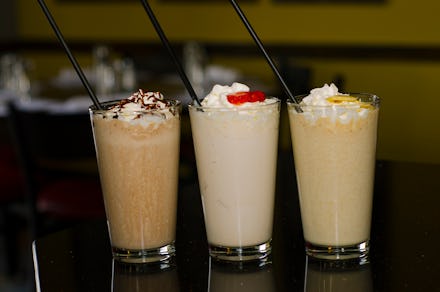Science Says Drinking Milkshakes Might Help You Keep Your Diet Goals on Track

"Phantom fullness" sounds like a Ghostbusters-themed weight loss plan, but it could actually be a secret weapon in keeping hungry dieters satisfied. Best of all, phantom fullness can be found in milkshakes.
Milkshakes for health? Booyah.
A new study published in the American Journal of Clinical Nutrition showed that the texture of milkshakes helped keep participants satiated between breakfast and lunch.
The study: 15 men with a mean BMI of 22.6 drank dairy-based milkshakes that contained 50% carbohydrate, 20% protein and 30% fat. The shakes differed in calories and thickness — some of the men drank thick shakes that were 100 calories or 500 calories, some drank thin (i.e. less viscous) ones that were 100 calories or 500 calories.
Afterwards, the participants got MRI scans to determine how quickly their stomachs emptied and each self-reported their appetite levels. They were also told to eat sandwiches until they were satisfied.
The results: Participants who drank the thin, low-calorie shake had the lowest (aka fastest) gastric emptying time, the time it takes for food to travel from the stomach to the small intestines. The thin, low-calorie shake had a mean time of 26.5 minutes, the thick, low-calorie shake had a mean time of 41 minutes, the thin, high-calorie shake had a mean time of 69.5 minutes, and the thick, high-calorie shake had a mean time of 81.9 minutes.
Even though it had 400 fewer calories, the thick 100-calorie shake led to greater feelings of fullness compared to the thin 500-calorie shake. Men who drank the thick 100-calorie shake rated their fullness as 58 points after 40 minutes, while men who drank the thin, 500-calorie shake rated their fullness as only 48 after 40 minutes.
Thick shakes decreased feelings of hunger
"The increase in perceived fullness that is due solely to the increased viscosity, which is a phenomenon that we refer to as phantom fullness, may be useful in lowering energy intake," the authors wrote.
This research is quite similar to the philosophy behind volumetrics, aka the strategy of eating high-volume, low-calorie foods for weight loss, can help promote satiety. Volumetric diets give consumers more mileage from what they eat, U.S. News and World Report noted. The "phantom fullness" from thick, low-calorie smoothies could be key to staving off hunger and preventing overeating for dieters, though more randomized trials would be necessary to confirm this.
WTF is phantom fullness?
The way consumers experience food textures can influence appetite and feelings of fullness, the study results show.
Study author Guido Campos told FoodNavigator that "mouthfeel" is key.
[The findings] underlie the importance of oral exposure and "mouthfeel characteristics" of a food product when it comes to influencing appetite. This is at least an indication that increasing the thickness of diet shakes may be an interesting avenue to pursue further.
How to make a thick milkshake or smoothie
In this study, researchers used locust bean gum, a food additive, to thicken the milkshakes. But that's not the only way to add some heft to a shake (or smoothie). Campos said in an email that other low-calorie fibers like guar gum and carb-based xatham gum can add viscosity to a smoothie, making it thicker without adding calories.
But if you're not a fan of food additives, you can still naturally up the thickness of a shake or smoothie with a few simple tricks. Registered Dietitian Nora Minno said in an email that freezing banana slices before tossing them in a blender with the rest of your shake ingredients can create a thicker smoothie. Adding oats, non-fat Greek yogurt, ice cubes made from milk or avocado is another other strategy for creating a filling smoothie. Just note: These ingredients will add both thickness and calories (but also good-for-you fiber and nutrients) to your smoothie.
Read more: